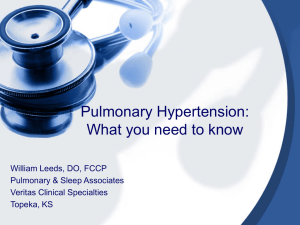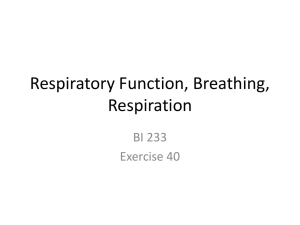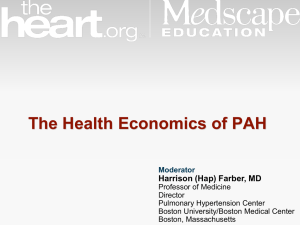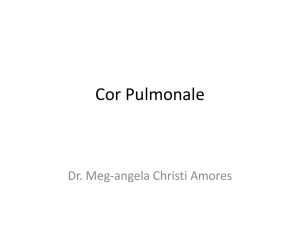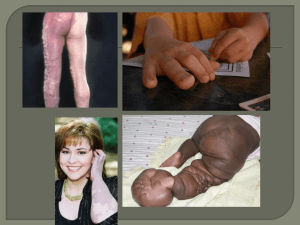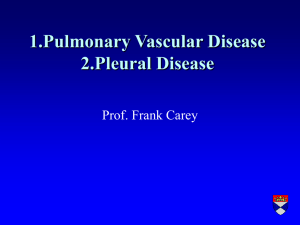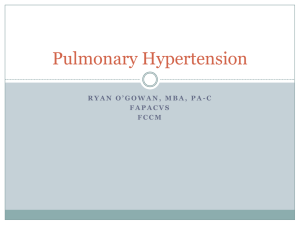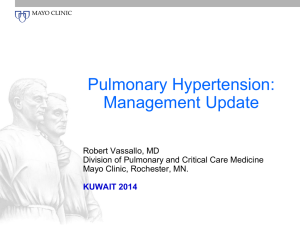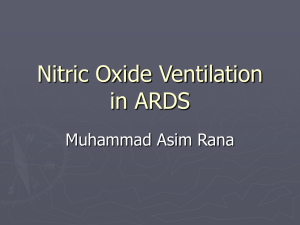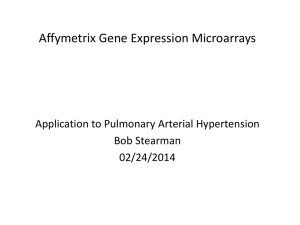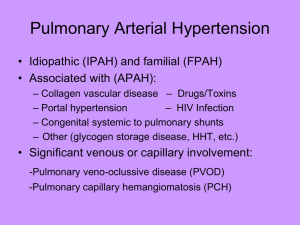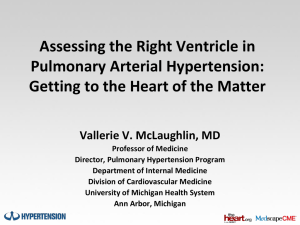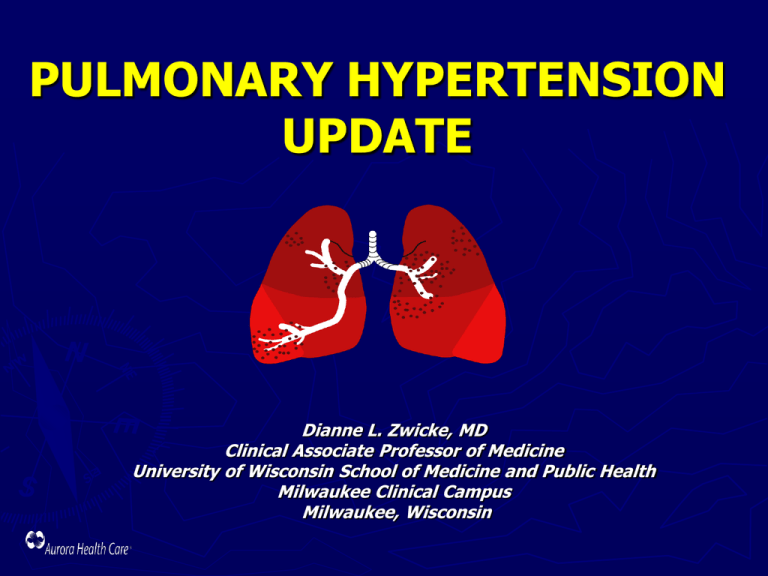
PULMONARY HYPERTENSION
UPDATE
Dianne L. Zwicke, MD
Clinical Associate Professor of Medicine
University of Wisconsin School of Medicine and Public Health
Milwaukee Clinical Campus
Milwaukee, Wisconsin
FINANCIAL DISCLOSURE
Dianne L. Zwicke, MD
Dianne L. Zwicke, MD
I have been an investigator and received study grants from the following companies:
Glaxo – Welcome
Myogen
PRE-DIX
Lilly
* Participated in Advisory Boards
*United Therapeutics
Encysive
*Gilead
Bayer
*Pfizer
Medtronic
Co Therix
Ikaria
Actileon
Novartis
GENO
PULMONARY HYPERTENSION
Vascular (PAH)
Non-Vascular
Mixed
Idiopathic
COPD
Congenital
Collagen Vascular
OSA
? COPD
Sickle Cell
ILD
? ILD
HIV
PE
? PE
Hepatopulmonary
Restrictive
Clinical Classification: Where Is the Lesion?
VC
RA
RV
PA
PC
PV
LA
LV
Ao
ALK-1, activin receptor-like kinase 1; Ao, aorta; BMPR2, bone morphogenetic receptor type 2; HHT, hereditary hemorrhagic
telangiectasia; HIV, human immunodeficiency virus; LA, left atrium; LV, left ventricle; PA, pulmonary artery; PC, pulmonary
capillary bed; PV, pulmonary vein; RA, right atrium; RV, right ventricle; VC, vena cava.
Simonneau et al. J Am Coll Cardiol. 2009;54(1 suppl S):S43-S54.
Graphic adapted from http://cme.medscape.com/viewarticle/530730.
PULMONARY ARTERIAL HYPERTENSION
►Mean
PA pressure > 24 mmHg
►PCWP
< 15mmHg
►PVR
> 2.5 / 3.0
PATHOLOGIC CHANGES
Vascular PH
► Smooth
muscle hypertrophy
► Intimal hyperplasia
► In situ thrombosis
► Arteritis
► Plexogenic lesion
PULMONARY HYPERTENSION
Severity by Mean PAP
26-35 Mild
36-45 Moderate
46-55 Severe
> 55
Systemic
Epidemiology of PAH (WHO Group 1)1
►
Prevalence of PAH in associated
conditions:
Distribution of PAH in French Registry8
CTDa: 8%-12%2,3
Appetite
suppressant
CHD: 15%-30%4
>1 Risk factor
IPAH
HIV
PoPH: 2%-6%5,6
HIV: 0.5%7
PoPH
CHD
FPAH
a Systemic
sclerosis.
CTD
CHD, congenital heart disease; CTD, connective tissue disease; FPAH, familial pulmonary arterial hypertension; HIV, human immunodeficiency virus; IPAH,
idiopathic pulmonary arterial hypertension; PoPH, portopulmonary hypertension.
1. Simonneau et al. J Am Coll Cardiol. 2009;54(1 suppl S):S43-S54. 2. Hachulla et al. Arthritis Rheum. 2009;60:1831-1839. 3. Mukerjee et al. Ann Rheum Dis.
2003;62:1088-1093. 4. Landzberg. Clin Chest Med. 2007;28:243-253. 5. Hadengue et al. Gastroenterology. 1991;100:520-528. 6. Krowka et al. Hepatology.
2006;44:1502-1510. 7. Sitbon et al. Am J Respir Crit Care Med. 2008;177:108-113. 8. Humbert et al. Am J Respir Crit Care Med. 2006;173:1023-1030.
VASCULAR PH EPIDEMIOLOGY
► Idiopathic
► Idiopathic
(Necropsy)
► Idiopathic (Familial)
► Connective Tissue
► HIV
► Hepatopulmonary
► Anorexic drug
1/500,000
750/500,000
191/1926
1-100/1000
5/100
5-8/100
12-25/500,000
1-Year Mortality Remains High in FC IV Patients1,2
1-Year mortality (%)
50
N=782
46
<30% on
prostanoid
40
29
30
20
10
9
0
II
III
IV
WHO FC
FC, functional class; QuERI, Quality Enhancement Research Initiative; WHO, World
Health Organization.
1. McLaughlin et al. Am J Respir Crit Care Med. 2009;179:A1043. 2. Mathier et al. Am J Respir Crit Care Med. 2009;179:A2658.
PULMONARY HYPERTENSION
RIGHT HEART FAILURE SYMPTOMS
►
DOE - 2 Years - 70%
►
Ascites - 20%
►
CP - RV ischemia - 30%
►
Peripheral edema - 10%
►
Syncope / near syncope – 30%
►
Early satiety - 50%
►
Fatigue - 90%
►
Hoarseness - 10%
►
Raynauds phenomonon – 10%
PULMONARY HYPERTENSION
Diagnostics - Basics
► History
& Physical
► Labs- CBC, CMP, TSH, ANA, RF, CRP,
ESR, HIV, ANTICARDIOLIPIN AB
► EKG, CXR
► Full PFT’S
► Lung scan
► Echo with contrast / TEE
PULMONARY HYPERTENSION
Diagnostics - Advanced
►
►
►
►
►
HR Chest CT
Pulmonary Angiography
Sleep study / screen
6 minute walk
Cardiac cath with pharmacologic
challenge -- LAST STUDY!
Hemodynamic Progression of PAH
Pre-symptomatic/
Compensated
Symptomatic/
Decompensating
Declining/
Decompensated
CO
Symptom Threshold
PAP
PVR
RAP
Right Heart
Dysfunction
Time
CO, cardiac output; PAP, pulmonary arterial pressure; PVR,
pulmonary vascular resistance; RAP, right atrial pressure.
Vasoactive Mediators Involved In PAH
ABNORMALITIES
Nitric oxide
deficiency
Prostacyclin
deficiency
Endothelin
overexpression
THERAPIES
PDE-5 inhibitors
Block the activity of PDE-5,
restoring vasodilation
through an increase in
cGMP1
Prostacyclin
Supplement the deficiency in
PGI2, resulting in vasodilation
and inhibition of platelet
aggregation2
ERAs
Block the binding of ET-1 to its
receptors, preventing
vasoconstrictor effects of ET-13
cGMP, cyclic guanosine monophosphate; ERA, endothelin receptor antagonist; ET-1, endothelin; PDE-5, phosphodiesterase type 5; PGI2,
prostacyclin.
1. Humbert et al. J Am Coll Cardiol. 2004;43(suppl S):13S-24S. 2. Humbert et al. N Engl J Med. 2004;351:1425-1436.
3. Galiè et al. Eur Heart J. 2004;25:2243-2278.
Overall PAH Therapy Use in Enrolled Population1,2
50
N=782
43
Patients (%)
40
30
28
25
22
20
10
0
PDE-5I
ERA
Prostanoid
Combination
ERA, endothelin receptor antagonist; PDE-5I, phosphodiesterase type
5 inhibitor; QuERI, Quality Enhancement Research Initiative.
1. McLaughlin et al. Am J Respir Crit Care Med. 2009;179:A1043. 2. Mathier et al. Am J Respir Crit Care Med. 2009;179:A2658.
Has Survival Meaningfully Improved With
Modern Therapies?
IPAH, HPAH, and anorexigen-associated PAH
100
After 2000 (current therapies)
1992-1999 (only IV PGI2)
Before 1992 (no specific Tx)
75
n=269
NS
n=260
50
25
n=118
P<0.05, log-rank test
0
0
12
24
36
48
60
Months
HPAH, hereditary pulmonary arterial hypertension; IPAH, idiopathic pulmonary arterial hypertension; IV, intravenous; NS, not
significant; PGI2, prostacyclin; Tx, treatment.
Sitbon et al. Slides presented at European Respiratory Society; September 16-18, 2007; Stockholm, Sweden.
PULMONARY ARTERIAL
HYPERTENSION
MEDICAL
THERAPIES
EPOPROSTINIL (Flolan, Veletri)
► Prostacyclin
► 75%
sustained in PVR
► 10%
are non responders
► Double
lumen catheter
► Requires
continuous infusion
BOSENTAN (Tracleer)
►
ET – 1 antagonist
►
Binds ETA – ETB receptors in endothelium and vascular smooth
muscle
►
P450 pathway (2C9, 3A4)
►
3-5 hour max plasma concentration
►
t½ is five hours
►
95% bound to albumin, excreted in bile
►
62.5 – 125 mg bid orally, 1-2 month Rx
TREPROSTINIL (Remodulin)
► UT
– 15
► Prostacyclin
► SQ
analogue
or IV infusion
► Modified
insulin pump – SQ
INHALED NITRIC OXIDE
► Endothelial
derived relaxing factor
► Endogenous
mediator for smooth
muscle relaxation
► Selective
pulmonary vasodilator through
cGMP pathway
► Increases
oxygenation
SILDENAFIL (Revatio)
►
PDE – 5 Inhibitor
►
Found abundantly in pulmonary vasculature
►
Inhibits proliferation
►
Potent pulmonary vasodilation
►
Increased epistaxis and GI bleed
►
Can’t prescribe nitrates
ILOPROST (Ventavis)
► Inhaled
► 6-9
prostacyclin derivative
treatments/day
► 10-15
► Mini
minutes/treatment
Nebulizer
AMBRISENTAN (Letairis)
►
Endothelin receptor blocker
►
WHO group 1-3, WHO class 2 or 3 symptoms
►
5 or 10mg daily, tablet
►
IPH, CTD, HIV, diet drugs
►
Caution=pregnancy; liver toxicity (Label removed)
INHALED EPOPROSTINIL (Flolan)
► 30-80ng
► Special
/ kg / min
delivery system
INHALED EPOPROSTENOL AS SOLO OR ADJUNCTIVE THERAPY FOR PULMONARY ARTERY HYPERTENSION
Dianne Zwicke MD, Krishna Nagendran MD, Faisal Hayat MD, Theodore Gronski MD, Jonathan Kay MD, Frank Spexarth
RPH, Wende Moline NP, Andrea Krause NP, Mori Naoyo PHD
University of Wisconsin School of Medicine and Public Health-Milwaukee Clinical Campus
Study Data
Introduction
Pulmonary arterial hypertension (PAH) is a common
finding in patients with significant valvular heart disease.
Post operative mortality is increased in these patients.
Currently, the most commonly used drug to rapidly
decrease pulmonary artery pressure is nitric oxide.
Epoprostenol (EPO) is less expensive, less toxic, and
easier to administer when compared to inhaled nitric oxide.
Inhaled EPO may be an alternative to IV EPO, as it has
selective pulmonary vasodilator properties and less
systemic side effects. Hache, et al, studied the effect of
inhaled EPO compared to a placebo in twenty patients
undergoing cardiothoracic surgery and concluded it was
safe. In our study, we treated patients with increased
pulmonary artery pressure, undergoing cardiothoracic
surgery, with inhaled EPO to determine efficacy.
Methods
The selected study population was patients undergoing
cardiothoracic surgery, at St Lukes Medical Center, in
Milwaukee, Wisconsin, between July 2008 and April
2009. Anesthesiologists prospectively initiated inhaled
EPO therapy, using the AccuNeb, on the vasodilated and
fully anesthetized patients, with a measured PA systolic
pressure greater than 60mmHg by Swan-Ganz catheter.
We collected data by chart review of the identified study
population. Pulmonary artery pressure and cardiac index
were compared using two sample paired t-test,
respectively (two-tailed).
Results
Of all patients, seventy two (82.8%) underwent valve
surgeries, seven (8.1%) had LVAD’s, and two (2.3%)
had heart transplants. Inhaled EPO was used as
adjuvant therapy in 6 (6.7%) medical patients. No
adverse effects from this therapy was observed.
Hemodynamic parameters are statistically significant.
Population demographics are presented in the table.
Number of Patients
SET UP
n=87
Average age
67
sex
M= 54 , F= 33
( Range 31-88 )
Heart Failure (EF < 40)
51
Average days on Ventilator
5
(58.6%)
Valve Disorders
Mitral Regurgitation (Total )
54
Severe / Moderate / Mild
27 / 17 /10
Tricuspid Regurgitation (Total)
30
Severe / Moderate /Mild
17 / 9 / 4
Aortic Stenosis
14
(Total)
Severe / Moderate
12 / 2
Aortic Regurgitation
10
Figure 2. Sulfur granule with surrounding lymphocytic infiltrate
Surgeries
Mitral valve Replacement
16
Mitral Valve Repair
28
Aortic Valve Replacement
21
Cardiac Index (Pre) (n=52) 2.12 +/- 0.5
Cardiac Index (Post)
PAP pre-op (Mean)
2.92 +/- 0.7 (p<0.001)
(n=56) 39 +/- 0.52
PAP Post-op (Mean)
25.1 +/- 0.5 (p<0.001)
Average cost inhaled EPO $19/hour
Average cost inhaled NO
$132/hour
Conclusion
Inhaled Epoprostenol demonstrated excellent
clinical and hemodynamic results and was well
tolerated in this critically ill subgroup of patients.
It was a cost effective alternative to inhaled nitric
oxide with a net savings more than $875,000 .
CLINICAL IMPLICATION
Based on this preliminary subset population analysis,
inhaled epoprostenol may be efficacious in wider clinical
settings for patients with pulmonary artery hypertension. It is
more cost effective. Further studies are warranted to guide
therapy in other clinical subsets of patients.
TREPROSTINIL (Tyvaso)
► Prostaglandin
► 2-12
– inhaled.
breaths / treatment qid
► Same
side effects as any Prostaglandin
during titration
TADALAFIL (Adcirca)
► PDE-5
inhibitor
► 20-40mg
► 36
daily po
hour ½ life
► Avoid
with Rifampin and Antifungals
PERCUTANEOUS INTERVENTION IN
PULMONARY HYPERTENSION
► Coil
Closure of PDA
► ASD Closure
► VSD Closure
► Atrial Septostomy
SURGICAL PROCEDURES IN
PULMONARY HYPERTENSION
► ASD
/ VSD Closure
► Mitral Valve Repair / Replacement
► Anomolous Pulmonary Venous Return
► Pulmonary Thrombo-Endarterectomy
► Open Lung Biopsy
► Pericardial Window / Drainage
CURRENT CLINICAL TRIALS
-
Oral Remodulin - (United Therapeutics)
-
Selexipag - (Actileon)
-
Combo Study vs single drug - Adcirca +/-Letairis (United Therapeutics / Gilead)
-
Riociguat with LV Failure and PHTN - (Bayer)
-
Tyvaso Registry - (United Therapeutics)
-
Implantable pump / continuous infusion Remodulin - (Medtronics)
-
Inhaled nitric oxide - (GENO)
-
Inhaled Nitric Oxide via Ambulatory Device (Ikaria)
-
Taladafil with LV Failure and PHTN (NIH)
-
Oral Beraprost (LungRx)
▪ Prostacyclins
▪ Nitric Oxide
▪ PD’s
▪ ERA
▪ Combo
CASES
48 y/o female PAH / ICM
► CREST
syndrome x 6 years
► Anterior
wall MI → LVEF 15-20%
► PAH
– RA-18, RV-86/22, PA-88/22 (55), W-16,
CI-1.8, PA-Sat 48%, Ao-92%, PVR-12.18 WU
► IV
Remodulin titrated to 100ng/kg/min
► Ambrisentan
► Digoxin
5→10mg po daily
0.25mg daily
48 y/o female PAH / ICM – (continued)
► Lasix
40mg daily
► K/Mg replacement
► Lisinopril 20mg daily / DC Coreg
► More Aggressive immunosuppression
___________________________________________
* LVAD – Heartmate II for 6-7 months
* Successfully transplanted (heart)
* Weaned off Remodulin
42 y/o male - Hep C ETOH Liver Dz
► Massive
► Normal
ascites, LE edema, severe RH failure
LV, no significant valve disease
► Right
Heart Cath….
Hepatic wedge - 18
RA – 18
RV – 19 / 22
PA – 92 / 25 (54)
CI – 1.9
PVR – 9 WU
42 y/o male - Hep C ETOH Liver Dz (continued)
IV Lasix, Dobutamine, Flolan
► Digoxin 0.25mg daily, K/Mg replacement
► Flolan changed to Veletri for home infusion
► Revatio 20mg tid added
________________________________________________
►
Liver transplant after PVR ↓ to 5 WU, CI >2.8
► ECHO = marked improvement of RVEF
________________________________________________
►
* 3 months after transplant – weaned off IV Veletri
* 9 months after transplant – weaned from Revatio
* Stable 1 year after cessation of all PAH drugs
69 y/o old female - HCM
►
NYHA 3, 3+ edema to mid thighs, + ascites
►
Severe DOE and muscle wasting
►
ECHO – mild RVH, mod LVH, RVSP 55, LVEF 65%
►
PHTN work up – negative
►
Cath – RA-18, RV-58/19, PA-55/22, CI-2.8, W-20, PA-Sat 55%, PVR3.2 WU,
►
Treatment – IV Lasix → CVVH
________________________________________________________________
* Home on peritoneal dialysis x 9 months
* Evaluate for transplant – status 7
PAH – Pulmonary Emboli
56 year old female with PE after Hysterectomy
► Well
until 3 years ago, 02 6L NC now
► Denied PTE at another institution
► Reviewed Pulmonary Angiogram
► RHC – RA 8, RV 65/20(35), CI 2.3, Sat-62%
► Coronary Angiogram
► Sent to San Diego
Vague
Symptoms
Major presenting
symptoms are
syncope, shortness
of breath and fatigue
Syncope is
prodrome
to death
Correct diagnosis must be
established
Empiric vasodilator
therapy is not
recommended
Treatment options are
frequently available if not
seen at end stage


